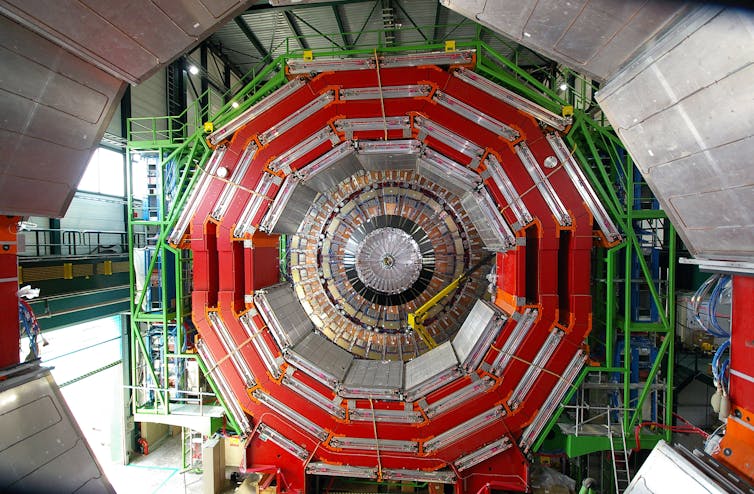When I began my undergraduate physics degree (around 20 years ago), “What is the theory of everything?” was a question that I heard often. It was used as a label for how theoretical physicists were trying to develop a deeper understanding of the elementary building blocks of our universe and the forces that govern their dynamics.
But is it a good question? Is it helpful in guiding scientists towards the discoveries that will advance our understanding to the next level? After all, good science relies on asking good questions. Or is it just “wishful thinking”?
Arguably, the question “What is the theory of everything?” reminds us that good science doesn’t have to start with the best questions. Let me explain what I mean.
Suppose we play a game. I have a deck of cards, and each card is printed with the name and a photograph of a different animal. I choose a card, and your job is to ask questions to find out which animal I have chosen. Of course, to ask a discerning question, you first need to know something about animals.
The first time you play, you may not be familiar with which animals are in the deck, and your first question is “Does it live in the sea?”. My answer is “No,” and the game continues. Then it is your turn to pick a card. You look carefully through the deck to make your choice, and you realise that it only contains land animals. “Does it live in the sea?” seemed like a good question to start with, but it was not.
We take turns, and the more we play, the quicker we seem to figure out which card has been chosen. Why? We have become better at asking good questions.
The role that questions play in scientific research is similar. We start from some level of understanding, and we ask questions based on that level of understanding to try to improve it. As our understanding builds, we refine our questions and get more insightful answers.
This is how progress is made. The same is true of asking “What is the theory of everything?”: the goodness of a scientific question is not immutable.
Why a ‘theory of everything’?
The Standard Model of Particle Physics, one of the pillars of modern science, is a success of reductionism - the idea that things can be explained by breaking them down into smaller parts.
The model, which is written in a mathematical language called quantum field theory, describes how elementary particles move around and interact with one another. It explains the nature of three out of four of the known fundamental forces: electromagnetism, and the weak and strong forces that govern processes on subatomic scales. It does not include gravity, the fourth force.
The model accounts for quantum mechanics, which describes the probabilistic nature of the dynamics of subatomic particles, and Einstein’s special theory of relativity, which describes what happens when relative speeds are close to the speed of light – no small achievement.
The assumption in asking “What is the theory of everything?” is that the Standard Model will one day be found to be embedded within a larger structure (with more elemental ingredients) that provides us with a unified explanation of the fundamental forces including gravity. Gravity, in fact, is this question’s ultimate focus.
But the question “What is the theory of everything?” gives very little guidance as to what such a theory of everything might look like. We need some better questions.
Now, there are good reasons to expect that such a unified explanation of the fundamental forces might exist: the Standard Model includes the celebrated Higgs mechanism, from which the Higgs boson arises. It explains why fundamental particles known as the W and Z bosons, which transmit the weak force, acquire a mass. It also explains why the photon, which transmits the electromagnetic force, does not.

CMS experiment at Cern. wikipedia, CC BY-SA
As a result, electromagnetism and the weak force, which is involved in the nuclear fusion that powers stars, behave differently at low energies: the electromagnetic force acts over very large distances, whereas the weak force acts only over very short distances. The Higgs mechanism also explains why, at higher energies, these two forces start to behave as a single “electroweak” force. This is called electroweak unification.
Now, if electromagnetism and the weak force combine in this way, why not all the forces in the Standard Model? Unifying these two with the strong force, the force that holds the ingredients of atomic nuclei together, is the aim of grand unified theories. Theoretical ideas such as supersymmetry, which postulates a symmetry between force carriers and matter particles, suggest that the strength of these three forces could get tantalisingly close at high enough energies.
And if the electromagnetic, weak and strong forces turn out to be unified, why not gravity, too?
Gravity is described by Einstein’s General Theory of Relativity, which applies on large scales or at low energies. But if we want a consistent quantum theory of gravity that applies on the smallest scales, quantum field theory isn’t enough. We need mathematical frameworks that can consistently incorporate both general relativity and quantum mechanics.
The “everything” in a “theory of everything” refers to all the known forces of nature: electromagnetism, the weak force, the strong force, and gravity (and new, hypothetical forces, too) and the particles that they act between. The “theory” refers to the existence of some common mathematical framework that describes all of the “everything”.
One such common mathematical framework is string theory, which supposes that the most fundamental building blocks of the universe are tiny strings that vibrate in extra spatial dimensions beyond the three of our everyday experience.
Better questions
Questions are the guide to scientific inquiry. The question “What is the theory of everything?” only speculates at a destination, but it gives very little direction.
Frameworks such as supersymmetry and string theory were not developed to answer the question “What is the theory of everything?” directly. They were motivated by better questions about what a theory of all the fundamental forces needs to explain and what it might look like, questions like: Why is there a huge discrepancy between the energy scales of the Standard Model and quantum gravity? Why do quantum mechanics and general relativity seem to be incompatible?
But the “whys” that theoretical physicists ask develop as our understanding develops, and the questions that we are now posing are getting us even closer than ever to an understanding of all the known forces of nature.
These new “whys” hint at remarkable connections between very different areas of physics and mathematics: Why does the physics of holograms seem to help us to understand gravity? Why does this seem to be connected to the properties of large collections of random numbers? Why do the rules of quantum information seem to explain the physics of black holes?
But this is not a case of “out with the old and in with the new”. Instead, these new questions have been reached by building on what has been learnt from developing and studying possible “Theories of Everything”, like string theory.
And these new questions are good questions. The exciting thing is that they still may not be the best questions, and having them to guide us doesn’t necessarily mean that we know where we will end up. That is what scientific discovery is all about.



 NASA Resumes Cygnus XL Cargo Docking with Space Station After Software Fix
NASA Resumes Cygnus XL Cargo Docking with Space Station After Software Fix  Lab-grown meat: you may find it icky, but it could drive forward medical research
Lab-grown meat: you may find it icky, but it could drive forward medical research  Trump and Merck KGaA Partner to Slash IVF Drug Costs and Expand Fertility Coverage
Trump and Merck KGaA Partner to Slash IVF Drug Costs and Expand Fertility Coverage  Neuren Pharmaceuticals Surges on U.S. Patent Win for Rare Disorder Drug
Neuren Pharmaceuticals Surges on U.S. Patent Win for Rare Disorder Drug  SpaceX’s Starship Completes 11th Test Flight, Paving Way for Moon and Mars Missions
SpaceX’s Starship Completes 11th Test Flight, Paving Way for Moon and Mars Missions  FDA Lifts REMS Requirement for CAR-T Cell Cancer Therapies
FDA Lifts REMS Requirement for CAR-T Cell Cancer Therapies  NASA Astronauts Wilmore and Williams Recover After Boeing Starliner Delay
NASA Astronauts Wilmore and Williams Recover After Boeing Starliner Delay  Cogent Biosciences Soars 120% on Breakthrough Phase 3 Results for Bezuclastinib in GIST Treatment
Cogent Biosciences Soars 120% on Breakthrough Phase 3 Results for Bezuclastinib in GIST Treatment  Trump Signs Executive Order to Boost AI Research in Childhood Cancer
Trump Signs Executive Order to Boost AI Research in Childhood Cancer  Kennedy Sets September Deadline to Uncover Autism Causes Amid Controversy
Kennedy Sets September Deadline to Uncover Autism Causes Amid Controversy  SpaceX Starship Test Flight Reaches New Heights but Ends in Setback
SpaceX Starship Test Flight Reaches New Heights but Ends in Setback  Trump Administration to Launch Autism Initiatives Targeting Acetaminophen Use and New Treatment Options
Trump Administration to Launch Autism Initiatives Targeting Acetaminophen Use and New Treatment Options 
































